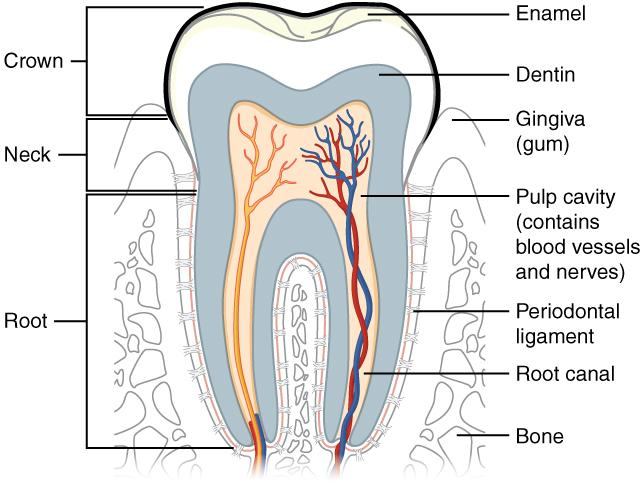
Draw a labelled diagram to show the internal structure of a mammalian tooth with two roots.
Answer
556.8k+ views
Hint:Teeth are similar to most vertebrates, but mammalian teeth are unique in their range of shapes and functions. The mammalian teeth include incisors, canines, premolars and molars, not all of which are found in all mammals.
Complete answer:
A tooth noticeable in your mouth is just half of your whole tooth. The base of the tooth is completely concealed in the bone of the jaw. The tooth is composed of enamel, dentin, mortar and dental pulp tissue. Enamel is the strongest body tissue on the top of the dental crown. It's about as strong as crystal. Dentin is the tissue that surrounds the tooth from the dental crown to the root of the tooth. It is found inside the cement and the enamel. The dental pulp is a fibre that is sometimes called the nerve. Blood vessels and lymph vessels, as well as nerve fibres, are found in the dental pulp and provide the dentin with nutrients.
Permanent teeth are the teeth you've been using for your whole life. The part of the tooth revealed to the oral cavity is known as the dental crown, and the section just below the dental crown is known as the root of the tooth. The dental pulp cavity resides in the middle of the tooth, from which the nerves called the dental pulp travel. The tooth is protected by tissue composed of the alveolar bone, the gum and the periodontal ligament.

Note: The shape of the tooth and the number of teeth in mammals have changed over human evolution. The canines are the third permanent teeth of the upper and lower jaws from the middle of the mouth to the back. They're used to tearing the food. The teeth behind the canines grind food like a factory. There are two molars in the milk teeth, one on the left and right sides of the upper and lower jaws.
Complete answer:
A tooth noticeable in your mouth is just half of your whole tooth. The base of the tooth is completely concealed in the bone of the jaw. The tooth is composed of enamel, dentin, mortar and dental pulp tissue. Enamel is the strongest body tissue on the top of the dental crown. It's about as strong as crystal. Dentin is the tissue that surrounds the tooth from the dental crown to the root of the tooth. It is found inside the cement and the enamel. The dental pulp is a fibre that is sometimes called the nerve. Blood vessels and lymph vessels, as well as nerve fibres, are found in the dental pulp and provide the dentin with nutrients.
Permanent teeth are the teeth you've been using for your whole life. The part of the tooth revealed to the oral cavity is known as the dental crown, and the section just below the dental crown is known as the root of the tooth. The dental pulp cavity resides in the middle of the tooth, from which the nerves called the dental pulp travel. The tooth is protected by tissue composed of the alveolar bone, the gum and the periodontal ligament.

Note: The shape of the tooth and the number of teeth in mammals have changed over human evolution. The canines are the third permanent teeth of the upper and lower jaws from the middle of the mouth to the back. They're used to tearing the food. The teeth behind the canines grind food like a factory. There are two molars in the milk teeth, one on the left and right sides of the upper and lower jaws.
Recently Updated Pages
A man running at a speed 5 ms is viewed in the side class 12 physics CBSE

State and explain Hardy Weinbergs Principle class 12 biology CBSE

Which of the following statements is wrong a Amnion class 12 biology CBSE

Two Planoconcave lenses 1 and 2 of glass of refractive class 12 physics CBSE

The compound 2 methyl 2 butene on reaction with NaIO4 class 12 chemistry CBSE

Bacterial cell wall is made up of A Cellulose B Hemicellulose class 12 biology CBSE

Trending doubts
What are the major means of transport Explain each class 12 social science CBSE

Which are the Top 10 Largest Countries of the World?

Explain sex determination in humans with line diag class 12 biology CBSE

Draw a labelled sketch of the human eye class 12 physics CBSE

How much time does it take to bleed after eating p class 12 biology CBSE

Suicide bags of cells are aEndoplasmic reticulum bLysosome class 12 biology CBSE




